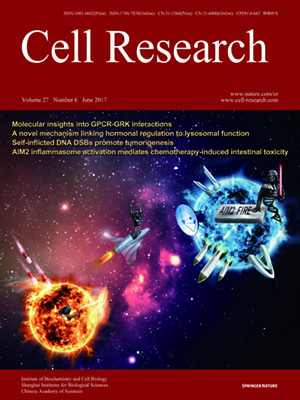
Volume 27, No 6, Jun 2017
ISSN: 1001-0602
EISSN: 1748-7838 2018
impact factor 17.848*
(Clarivate Analytics, 2019)
Volume 27 Issue 6, June 2017: 830-833 | Open Access
LETTERS TO THE EDITOR
Gene and mutation independent therapy via CRISPR-Cas9 mediated cellular reprogramming in rod photoreceptors
Jie Zhu1,2,*, Chang Ming3,*, Xin Fu1,2,*, Yaou Duan2, Duc Anh Hoang3, Jeffrey Rutgard2, Runze Zhang2, Wenqiu Wang2, Rui Hou4, Daniel Zhang2, Edward Zhang2, Charlotte Zhang2, Xiaoke Hao5, Wenjun Xiong3 and Kang Zhang1,2,6
1Guangzhou Women and Children's Medical Center, Guangzhou Medical University, Guangzhou 510623, China
2Shiley Eye Institute, Institute for Engineering in Medicine, Center for Genetic Therapy at Institute for Genomic Medicine, University of California, San Diego, La Jolla, California 92093, USA
3Department of Biomedical Sciences, City University of Hong Kong, Hong Kong SAR, China
4Guangzhou KangRui Biological Pharmaceutical Technology Company, Guangzhou 510005, China
5Department of Clinical Laboratory Medicine, Xijing Hospital, Fourth Military Medical University, Xi'an, Shanxi 710032, China
6Veterans Administration Healthcare System, San Diego, California 92037, USA
Correspondence: Xiaoke Hao, E-mail: haoxkg@fmmu.edu.cn; Wenjun Xiong, E-mail: wenjun.xiong@cityu.edu.hk; Kang Zhang,(kang.zhang@gmail.com)
We report a gene therapy strategy using CRISPR/Cas9-mediated cellular reprogramming by switching a mutation-venerable/sensitive cell type to a mutation-insensitive/resistant cell type, therefore restoring tissue architecture and function. We applied this strategy to retinitis pigmentosa (RP), a major cause of blindness characterized by retinal rod photoreceptor degeneration caused by numerous mutations in many genes. By reprogramming rod to cone-like photoreceptors in situ by inactivating Nrl or Nr2e3, we show an increase in cone-like cells with remarkable concomitant preservation of both cone and rod photoreceptors and retinal tissue, with restoration of visual function. Our approach demonstrates the feasibility of cellular reprogramming in preventing degeneration and preserving tissue and function, and points to a novel approach in treating human diseases in a gene and mutation independent manner.
10.1038/cr.2017.57
FULL TEXT | PDF
Browse 2065


